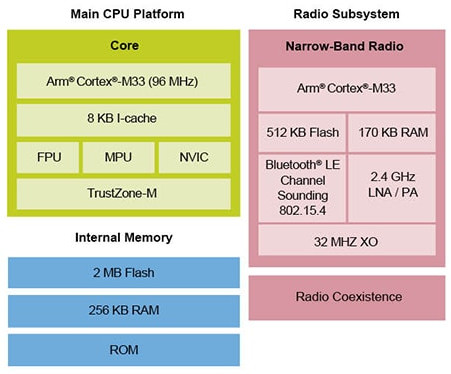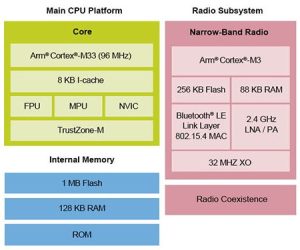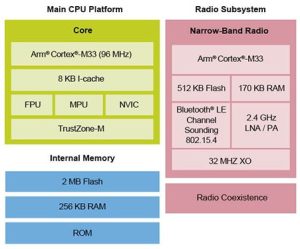
“Featuring the industry’s first MCU with Bluetooth Channel Sounding, NXP’s MCX W series enables edge devices with secure multi-protocol wireless for Matter, Thread, Zigbee and Bluetooth Low Energy,” according to the company, which explained: “Bluetooth Channel Sounding standard improves the accuracy and security of distance measurement compared to traditional Bluetooth for applications such as secure access, asset tracking and indoor way-finding.”
The first MCX W families each have a pair of Arm Cortex-M33 processors – a 96MHz core for application processing, and the second to run the radio (core speed not yer revealed).
MCX W72x (block diagram above) is the channel sounding version, and has 512kbyte flash plus 170kbyte ram with the radio processor, while its application processor gets 2Mbyte flash plus 256kbyte ram.
Channel sounding is processed in a dedicated ‘localisation compute’ accelerator, and the memory is sufficient to support connectivity stacks, said NXP, while the radio subsystem can run “the full Thread or Zigbee stack alongside the Bluetooth Low Energy stack”.

The company sees these in simpler single-chip IoT devices, or as a wireless co-processor for a powerful host in more complex products.
In all the devices announced so far, Bluetooth LE 5.x with 24 simultaneous hardware connections is supported, and receive specs for the 2.4GHz radio are 106dBm 125kbit/s, 102dBm 500kbit/s, 97.5dBm 1Mbit/s or 95dBm 2Mbit/s. Transmit is up to +10dBm.
The M33 application processor gets Arm’s TrustZone for securely separating multiple code blocks, and there is an integrated root-of-trust.
“MCX W series helps accelerate compliance with upcoming cyber security regulations such as the US Cyber Trust Mark and European Cyber Resilience Act, and other security standards such as IEC 62443, leveraging an integrated Core Profile EdgeLock Secure Enclave that protects sensitive security functions and natively supports EdgeLock 2go services,” said NXP. “It also includes device authentication, secure boot, and secure firmware install and update. It accelerates connectivity standards’ cryptography with secure key install and management in untrusted manufacturing sites.”
As secured over-the-air-upgrade is supported, end user equipment can be upgraded “as consumer needs change and connectivity protocols like Matter continue to evolve”, said NXP.
Industrial applications
Potential industrial use is supported by operation over -40 to 125°C, interfaces such as CAN-FD featuring in the series, and NXP’s 15 year product longevity programme to which the parts are subject.
Development tools are built around the MCUXpresso suite and will include wireless-certified boards, a debug probe and stacks for Matter, Thread, Zigbee and Bluetooth Low Energy.
The MCX W series will begin sampling in the second half of this year, starting in a 7 x 7mm QFN48 package.
Initial product pages:
simpler W71x
W72x with channel sounding







